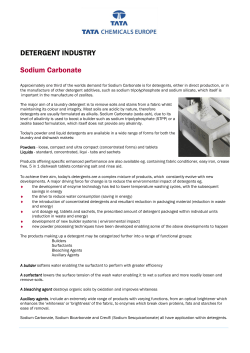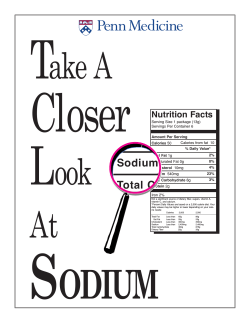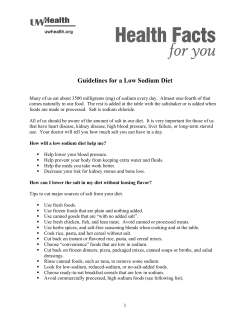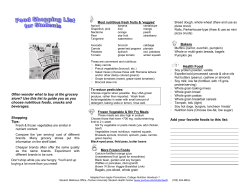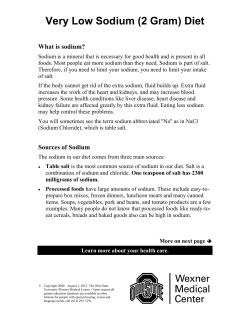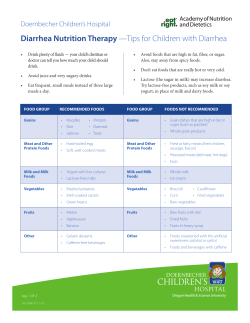
Module How to Follow a Low-Sodium Diet 2
Module 2 How to Follow a Low-Sodium Diet The Heart Failure Society of America (HFSA) is a non-profit organization of health care professionals and researchers who are dedicated to enhancing quality and duration of life for patients with heart failure and preventing the condition in those at risk. These educational modules have been developed to help patients, their families, and individuals at risk for heart failure understand and cope with the disease. For more information about the Society please visit our web site www.hfsa.org. www.hfsa.org © copyright 2002 Heart Failure Society of America, St. Paul, MN Reprinted 2006 C o n t a c t In f o rm a t i o n Please write down important contact information in the space below. You may also want to share this information with family members and friends. Doctor Treating Me for Heart Failure: Name: It is important to decrease the amount of sodium you eat when you have heart failure, because heart failure causes the body to hold on to extra sodium. The sodium causes extra fluid to build up in your body. The extra fluid makes your heart work harder. It also causes symptoms such as swelling of the ankles, feet or abdomen, shortness of breath, or weight gain. A low-sodium diet can help you, even if you do not have symptoms of fluid build up, or if you are already taking a diuretic (water pill). Address: City: Introduction State: Zip code: Phone number: Fax: E-mail: Other Important Phone Numbers: Ambulance, fire department, or emergency services: 911 Pharmacy: Other doctors or nurses: © copyright 2002 Heart Failure Society of America, St. Paul, MN You may have heard your doctor or nurse talk about a low-sodium diet or a low-salt diet and may wonder whether they are the same or different diets. In practical terms, there is no difference between the two. Doctors and nurses usually use the terms sodium and salt to mean the same thing. This module will use the word sodium except when actually referring to table salt. The typical American diet is very high in sodium. Even if you do not add salt while cooking or do not use the salt shaker at the table, you are probably eating too much sodium. That is because we eat processed foods, like frozen dinners, boxed noodle and rice dishes, canned soups, and canned vegetables. Most processed foods are high in sodium. It may take some time to adjust to a low-sodium diet, but it is worth the effort. A low-sodium diet can help you feel better and allow your heart failure medicines to work better. It may even keep you out of the hospital. 1 What is a Low-Sodium Diet? Note that while this module concentrates on following a lowsodium diet, other nutritional issues may be of concern to you as well. For example, everyone should watch the amount of fat they eat. Also, if you have diabetes, you should watch the amount of sugar you eat. These issues are discussed in more detail in Module 8: Lifestyle Changes. This module provides information on: ❚ How to follow a low-sodium diet. ❚ The sodium content of selected foods and condiments. ❚ Substitutes for high-sodium foods and condiments. It will help you: A low-sodium diet includes no more than 2,000 to 3,000 milligrams (mg) of sodium per day. That is the same as 2 to 3 grams of sodium a day. To give you an idea of how much that is, 1 teaspoon of salt = approximately 2,300 mg sodium. People with mild heart failure (no or mild symptoms with vigorous or moderate exercise) are usually asked to limit their sodium intake to 3,000 mg per day. People with moderate to severe heart failure (symptoms with light exercise, household chores or at rest) are usually asked to limit their sodium intake to 2,000 mg per day. Check with your doctor or nurse on the sodium limit that is best for you. ❚ Reduce your sodium intake. ❚ Cook meals with low-sodium foods. ❚ Make good choices when you eat in a restaurant. This module has a lot of information in it. You don’t have to read it all at once. You may find it helpful to read it by sections and to come back whenever you have questions about a lowsodium diet. How Do I Follow a Low-Sodium Diet? You can take four basic steps to reduce the amount of sodium in your diet: 1. Stop adding salt to your food. 2. Adapt your preferred foods to low-sodium versions. 3. Pick foods naturally low in sodium. 4. Learn to read food labels. 2 3 Step 1: St op Adding Salt to Food To accomplish this step, try the following tips: ❚ Take the salt shaker off of the table. ❚ Do not add salt when cooking. You can reduce your sodium intake by as much as 30 percent by following the first two tips. People often say that food tastes bland without salt. You can make foods taste good without salt by trying the following tips: ❚ Experiment with low- or no-salt herbs, spices, and seasoning mixes. Try using seasonings like black, cayenne, or lemon pepper. Dried and fresh herbs such as garlic, garlic or onion powder (not salt), dill, parsley, and rosemary are also naturally very low in sodium. Combination spice mixes in a bottle are great as long as sodium or salt is not one of the ingredients. ❚ Sprinkle fresh lemon juice over vegetables and salads. Season or marinade meat, poultry, and fish ahead of time with onion, garlic, and your favorite herbs before cooking to bring out the flavor. ❚ Avoid spices and seasoning mixes with the word salt or sodium in the name. They will be high in sodium. For example, just a teaspoon of a seasoned salt such as garlic salt or celery salt contains about 1,500 mg of sodium. The chart on page 27 lists high-sodium seasonings. It can be fun learning new ways to eat. The chart on page 26 lists low-sodium seasonings to use when cooking. There are many salt-free seasoning mixes in your supermarket. Look in the spice section for seasonings labeled “salt-free”. 4 5 St e p 2 : Adap t Yo u r Pre f e r re d Fo o d s to L ow - So d i u m Ve r s i o n s To do this, try these tips: ❚ Consider getting a low-salt cookbook. You can find excellent low-salt cookbooks at your local library. You can also buy one at a bookstore or on the Internet. After getting used to low-sodium eating, you will be able to adapt your favorite recipes to low-sodium versions. For example, if you like soup, make your own low-sodium version with fresh meat and vegetables. Toss the ingredients into a slow cooker, and use herbs and spices for seasonings. Make extra and freeze some for later meals. ❚ Look for low-sodium versions of the foods you like. Many types of canned goods are now available in low-sodium versions. Look for canned foods labeled sodium-free, no-salt, low-sodium, light in sodium, very low-sodium, reduced-sodium, less-sodium, or unsalted. You can also remove some sodium from canned foods by rinsing them. Keep in mind that this does not remove all of the sodium. ❚ Select low-sodium cheeses or yogurt when making sauces. ❚ Use low-sodium substitutes for foods that you like. For example, prepare a fresh lean pork roast instead of a country ham. You can cook fresh chicken, turkey, roast beef, or pork without adding salt and use the meats for sandwiches instead of packaged lunch meats. Use fresh lettuce, tomato, and onion for flavoring. The chart on page 35 lists a variety of low-sodium alternatives for high-sodium foods. 6 7 Step 3: Pick Foods Naturally Low in Sodium To accomplish this step, try the following tips: ❚ Choose fresh foods. Fresh fruits and vegetables including freshly squeezed fruit and vegetable juices have very little sodium. The same is true for fresh meat, poultry, and fish. Generally, you can eat as much fresh food as you want without counting the sodium content. So, think fresh when choosing foods. ❚ If you are not eating fresh foods, choose other low-sodium foods as much as possible. Other good options include canned fruits and plain frozen vegetables. Dried beans, peas, rice, and lentils are also excellent low-sodium foods, but make sure not to add salt or other ingredients such as salt pork when cooking them. 8 9 Step 4: L e arn to Read Food Labels By reading food labels, you can learn which foods are high and low in sodium. As a rule, most processed foods whether they are frozen, canned, or boxed, are high in sodium. For example, most frozen TV dinners, frozen snack foods such as pizza rolls and egg rolls, canned vegetables, and instant hot cereals are high in sodium and should be avoided. But not all processed foods are high in sodium. Some packaged foods are available in low- or no-salt versions. Sometimes it is hard to know what to eat. The only way to know for sure is to read the food label. It is especially important to read the labels of processed foods or any foods with which you are unfamiliar. The charts on pages 28-31 list some high- and low-sodium foods, so you can get an idea of which foods you should choose and which ones you should avoid. The next section will teach you how to read a food label for sodium content. 10 11 Re a d i n g a Fo o d L a b e l fo r So d i u m C o n t e n t Nutrition Facts Serving Size 5 oz Servings Per Container 4 The serving size for the food above is 5 oz. (ounces). The sodium content for that serving is 440 mg. Amount Per Serving Calories 90 Calories from Fat 30 % Daily Value* Total Fat 3g Saturated Fat 0g Cholesterol 0mg Sodium 440mg Total Carbohydrate 13g Dietary Fiber 3g Sugars 3g Protein 3g Vitamin A Calcium 80% 4% • • 1. Begin by reviewing the serving size and sodium content information. See the shaded areas on the sample label to the left. 5% 0% 0% 19% 4% 4% 2. If you eat the same sized serving as the one listed on the label, then you are eating the amount of sodium that is listed. 3. But if the amount you actually eat is either larger or smaller, the amount of sodium you will be eating will also be larger or smaller. For example, if you eat a double portion of the food shown on the label to the left, you will also be eating twice as much sodium as listed on the label. A 10 oz. serving of the food above would contain 880 mg of sodium. Vitamin C 60% Iron 4% * Percent Daily Values are based on a 2,000 calorie diet. Your daily values may be higher or depending on your calorie needs: More nutrients may be listed on some labels. 12 13 Ot h e r Tips to Help You Get Star ted It can be difficult to change your eating habits. It may take weeks before you enjoy the taste of low-sodium foods, but your taste buds will adjust. Eventually you may not even miss the salt. The tips listed below can help you get off to a good start: ❚ Make changes slowly instead of all at once. ❚ Adapt things you like to eat so they are lower in sodium, rather than trying to totally change your diet. ❚ Keep a list of low-sodium foods in the kitchen. The refrigerator is a good spot. The chart on page 33 lists some low-sodium foods. To detach this chart, tear along the perforated line. ❚ Learn which foods are high-sodium, and do not buy them. That way you will not be tempted to eat them. The chart on page 34 lists some high-sodium foods. ❚ When picking entrees or main food items, no more than one food item should have more than 500 mg of sodium. Think about it this way – if your doctor or nurse recommended that you eat 2,000 mg of sodium in a day, 500 mg is one-fourth of your daily amount. ❚ Make a list of the amount of sodium you eat with each meal for a few days. The next section explains how to track your sodium intake. 14 15 16 Snacks 17 Day 4 Day 3 Day 2 Day 1 You can also review the list of what you ate with your nurse, doctor, or dietitian to find out how your sodium intake compares to what is best for you. Dinner Add up the amount of sodium you ate each day. If you find that you ate more than 2,000-3,000 mg of sodium each day, look at each item on the list to figure out which foods caused the trouble. Think about where you might be able to cut down on sodium. Lunch If you don’t know the sodium content of a particular food, write down the food anyway. Your nurse or dietitian will work with you to estimate the sodium content. You can also look up the sodium content of foods on the Internet. Tr a c k i n g t h e So d i u m Yo u E a t You can use the chart on the next page to track what you eat. A full-page version of the chart can be printed from our web site: www.abouthf.org. Breakfast To find out how much sodium you are eating, keep a record of everything you eat and drink for four days. Do not forget to include snacks. Keep a record of everything you eat and drink for four days of typical eating. Review your chart with your nurse or dietitian to be sure that you are not consuming too much sodium. Tr a c k i n g t h e S o d i u m i n Yo u r D i e t Qu e s t i o n s t o A s k Yo u r Do c t o r o r Nu r s e What is my sodium limit per day? Reason for asking this question: Most people with heart failure should limit their sodium intake, even if they do not have symptoms. Following a low-sodium diet will help prevent fluid from building up in your body and may even decrease your need for some medications. Your doctor or nurse is the best person to tell you exactly how much sodium you can eat each day, but they may forget to discuss this important aspect of your care. So ask them about your sodium limit. I hear a lot about sodium, but what about potassium? Should I be on a diet that is high or low in potassium? Your doctor or nurse should check your blood potassium level and tell you if you need to do anything special to keep your potassium level normal. If you have low potassium, your doctor or nurse may advise you to eat foods high in potassium. They may also prescribe a potassium pill to make sure you are getting enough potassium. If your doctor or nurse suggests that you eat foods high in potassium, try the following: Potatoes and sweet potatoes Avocados Bananas Spinach Broccoli Strawberries Cantaloupe Tomatoes Dried fruits (prunes, dates, raisins) Whole grains Nuts Winter squash Oranges and other citrus fruits Reason for asking this question: Your body needs potassium to work properly, so it is important that you have the right amount in your blood. Some heart failure medicines can cause potassium levels to go either up or down. For example: But if your potassium level is high, your doctor or nurse may advise you to avoid eating certain foods and salt substitutes containing potassium. Always check with your doctor or nurse before using salt substitutes that contain potassium. ❚ Water pills may cause a drop in potassium. ❚ Angiotensin-converting enzyme (ACE) inhibitor and spironolactone pills may cause an increase in potassium. (See Module 3: Heart Failure Medicines for definitions and more information). 18 19 Qu e s t i o n s a n d A n s we r s Abou t a L ow - So d i u m Di e t Question: Are there sources of sodium that I need to watch out for? Question: How can I follow a low-sodium diet when I eat out? Answer: Most of the sodium we eat comes from salt, but sodium can also be found in many foods, drinks, and medicines. Answer: Many people go out to eat several times each week. Eating out, whether it is at a restaurant, a friend’s house, or a party, can be challenging if you are on a low-sodium diet. Some things you should know about sodium that can help you eat less of it: But you can go out to eat and maintain a low-sodium diet, if you are careful. ❚ If your doctor or nurse prescribes an antibiotic, ask for one without sodium. ❚ The chemical symbol for sodium is Na. You may also see the symbol NaCl for sodium chloride. ❚ Watch for the word soda on food labels. For example you may see sodium bicarbonate (baking soda) or sodium carbonate on packages. These products contain sodium compounds. Try to avoid them if possible. ❚ Preservatives account for much of the sodium in processed foods. The names of some high-sodium preservatives are: sodium alginate, sodium sulfite, sodium caseinate, and sodium benzoate. Use the following tips while eating out: ❚ Choose restaurants that offer fresh food choices. ❚ Pick preparations without breading, because breading contains salt. ❚ Be specific about what you want and how you want it prepared when ordering. For example, ask that your food be prepared without added salt, monosodium glutamate (MSG) or soy sauce. ❚ Do not be afraid to question your waiter about how the food is prepared. ❚ Some over-the-counter drugs have large amounts of sodium. Carefully read the labels. Avoid products such as fizzing drugs. 20 21 Questi o n s a n d A n s we r s ( c o n t . ) ❚ Choose foods without sauces or ask for sauce and salad dressing “on the side”. If you use salad dressing, dip the tines of your fork into the dressing cup and then pierce your food, instead of pouring the dressing over your food. That way you get the flavor without all the sodium. Use the same technique with other types of sauces such as barbecue, steak, creamed, cheesy, Hollandaise, Alfredo, or red spaghetti sauces. It also works with gravies. ❚ Limit use of condiments that are high in sodium such as Worcestershire sauce, steak sauce, or ketchup. ❚ Avoid dishes named au gratin, Parmesan, hashed, Newberg, casserole, and Devonshire, because they are high in sodium. ❚ Be careful of foods that are labeled as good for your heart. These foods are usually low-fat, but they may be high in sodium. In many cases, salt is used to flavor low-fat foods. ❚ Choose the salad bar. It can be an excellent way to eat a low-sodium meal in a restaurant. But remember the following guidelines when selecting items: • Choose fresh vegetables, fruits, and eggs served in their natural state. That includes lettuce greens, spinach greens, tomatoes, cucumbers, onions, radishes, green peppers, red peppers, alfalfa sprouts, fresh mushrooms, broccoli, cauliflower, carrots, red cabbage, and hard boiled eggs. • Avoid high-sodium foods including croutons, green olives, black olives, shredded cheese, bacon bits, macaroni salad, potato salad, coleslaw, sunflower seeds, pepperoni, Chinese noodles, pickles, and creamy salad dressings. • Choose the following salad dressings: oil and vinegar, lemon, and flavored vinegars such as balsamic and raspberry. • Avoid the regular, light, and fat-free dressings unless you order on the side and dip your fork tines in the dressing. They are all high in sodium. ❚ If you are at a party, eat fresh fruits and raw vegetables instead of snack foods such as potato chips, salted popcorn, pretzels, or peanuts. Avoid the dips and party spreads because of their high sodium content. If you decrease your sodium intake before and after a big event where you may be eating a lot of high-sodium foods, you can help prevent your body from retaining fluid. 22 23 Questi o n s a n d A n s we r s ( c o n t . ) Question: What can I do to stay on my diet at a fast food restaurant, pizza parlor, or deli? Answer: Eating at a fast food restaurant, pizza parlor, or deli can be especially difficult, because most of the menu items are very high in sodium. The chart on page 37 lists the sodium content in some typical types of fast foods. Still it is possible to make lower sodium choices, if you try the following: At fast food restaurants, choose: ❚ A hamburger or grilled chicken sandwich without condiments. Add small amounts of mustard or mayonnaise yourself. ❚ French fries without salt. ❚ The salad bar. At a deli, choose: ❚ The salad bar. ❚ Vegetarian sandwiches with fresh vegetables, including lettuce, spinach, tomato, onion, fresh mushrooms, radishes, cucumbers, and sprouts. ❚ Use small amounts of mayonnaise (1 tablespoon contains 75 mg of sodium) or mustard (1 teaspoon contains 55 mg of sodium) as condiments. ❚ Avoid items such as the deli meat and cheese sandwiches, sardines, caviar, and pickled or brined foods such as olives. At a pizza parlor, choose: ❚ Less sauce. ❚ More vegetable toppings. ❚ Ask for fresh mushrooms, green peppers, fresh tomatoes, onions, and other fresh vegetables. ❚ Part-skim mozzarella cheese. ❚ Avoid pepperoni or sausage and processed cheeses such as Parmesan. 24 25 Measurement Key Ounce = oz. Tablespoon = tbsp. Milligram = mg Teaspoon = tsp. Examples of low-sodium spices, herbs, seasonings, and condiments Examples of high-sodium spices, seasonings, and condiments Allspice Garlic powder Alfredo mixes Pickle relish Basil Ginger Barbecue sauce Plum sauce Bay leaves Lemon juice Celery salt Poultry seasoning Black pepper Low-sodium ketchup (limit to 1-2 tbsp.) Cocktail sauce Regular ketchup Dry meat marinade mixes Salt Dry salad dressing mixes Salt sense Fish sauce Sea salt Garlic salt Seasoned salt Generic sauce mixes Soy sauce Horseradish Steak sauces Kosher salt Stir fry mixes Lite salt Stir fry sauce Lite soy sauce Taco sauce Meat tenderizer Taco seasoning MSG Teriyaki sauce Onion salt Worcestershire sauce Cayenne pepper Nutmeg Celery powder Onion powder Chili powder Oregano Chives Paprika Cinnamon Parsley Cloves Pimento Cocoa powder Red pepper Cumin Sage Curry Salt substitute (with physician’s approval) Dill Dry mustard Tabasco pepper sauce (1 tbsp. OK) Flavored extracts (vanilla, almond, etc.) Thyme Fresh garlic Vinegar 26 27 Examp l e s o f So d i u m C o n t e n t o f Se l e c t e d Fo o d s Foods with less than 10 mg of sodium per serving Foods with 40–65 mg of sodium per serving Fruit and fruit juices (fresh, frozen or canned) Beef, pork, lamb, and poultry (fresh, 3 oz.) Sugar Unsalted nuts Honey Unsalted peanut butter (but not regular peanut butter) Hot cereals such as oatmeal, wheat, and oat bran (regular cooking, not instant which is high in sodium, 1 cup with no salt added while cooking) Jelly beans (10 large) Macaroni, noodles, rice, and barley (cooked in unsalted water with no added salt, 1 cup) Fruit-filled cookies (1) Corn tortilla (1) Shrimp (2 oz.) Egg (1) Unsalted butter or margarine (but not regular) Foods with 65–120 mg of sodium per serving Unsalted dry curd cottage cheese (1/2 cup) Clams, steamed (3 oz.) Milk (whole or skim, 1 cup) Ice cream (1/2 cup) Mustard, chili, and hot sauce (1 tsp.) Vegetables (most types fresh or frozen except those in the 10–40 mg section) Salt-free herbs and spices (most) Fish (fresh, 3 oz.) Mayonnaise (1 tbsp.) Yogurt (1 cup) Milk (evaporated,1/2 cup) Vinegar Shredded wheat or puffed rice type cereals (1 cup) Foods with 120–175 mg of sodium per serving Foods with 10–40 mg of sodium per serving Bread (some types, 1 slice) Olives (ripe, 5) Chocolate covered peanut butter cups (2) Sardines (1 large) Beets (1/2 cup) Kale (3/4 cup) English muffin (1/2) Beet greens (1/3 cup) Soda pop (8 oz.) Carrots (1 cup) Spinach (1/2 cup cooked) Ketchup and steak sauce (1 tsp.) Celery (2 stalks) Vanilla wafers (2 cookies) Club soda (8 oz.) White wine (4 oz.) Peanut butter (regular, 2 tbsp.) Granola type cereal (1/2 cup) 28 29 Examp l e s o f So d i u m C o n t e n t of Se l e c t e d Fo o d s ( c o n t . ) Foods with 175–350 mg of sodium per serving Foods with more than 800 mg of sodium per serving Buttermilk (1 cup) Baking soda (1 tsp.) Cereal (ring, nugget, and flaked, 2/3 to 1 cup) Cheese (grated packaged, 1/4 cup) Tuna (canned, 3 oz.) Clams (canned, 1/4 cup) Vegetables (canned, 1/2 cup) Foods with 350–500 mg of sodium per serving Cottage cheese (low-fat, 1/2 cup) Beans (canned, 1/2 cup) Cheese (2 oz. of cheddar, 3/4 cup of cottage cheese, 1/2 cup of Parmesan, 1 1/2 oz. of processed cheese, 2 oz. of Swiss cheese) Main dishes (canned or frozen) Bouillon cube (1 cube) Pork and beans (canned, 1 cup) Chicken broth (canned, regular, 1 cup) Corned beef (3 oz.) Pudding (instant chocolate, 1 cup) Dill pickle (1 large) Sauerkraut (2/3 cup) Ham (lean, 3 oz.) Soup (canned, 1 cup) Lunch meats (2 oz.) Soy sauce (regular, 1 tbsp.) Macaroni and cheese (packaged, 1 cup) Spaghetti sauce (bottled, 1 cup) Pancake (1, 6-inch) Tomato juice (canned, 3/4 cup) Foods with 500–800 mg of sodium per serving Salad dressing (average, 2 tbsp.) Chicken broth, canned and reduced sodium (1 cup) Soups (some canned, 1 cup) Chili beans (1/2 cup) Cornbread (2-inch square) Soy sauce (lower sodium, 1 tbsp.) Hot dog (beef and chicken, 1) Stuffing mix (boxed and prepared, 1/2 cup) Pork sausage (2 links) Pot pie (beef and chicken, 1/3 of 9-inch diameter) 30 31 Low-Sodium Foods Beans, peas, rice, lentils, or pasta (dried and fresh, cooked without salt) Cereals (hot, regular cooking) Club soda Coffee (regular and decaffeinated) Fruits (fresh, frozen, and canned) Fruit drinks To detach, tear along perforated line. Herbs and spices (non-salt) Lemonade Meats, fish, and poultry (fresh) Milk (chocolate skim) Milk (evaporated skim) Milk (nonfat dry) Milk (skim, low-fat, and regular) Seltzer water (flavored) Soda pop (regular and diet) Soy milk Tea (iced) Vegetables (fresh and plain frozen) Yogurt (plain and fruit flavored) 32 33 Hi g h - So d i u m Fo o d s Meats Vegetables Anchovies Pickles (sweet and dill) Bacon Pizza sauce Beef jerky Regular canned vegetables Bologna Regular jarred and canned tomatoes Braunschweiger Breaded meat (frozen) Breakfast sausage Chipped ham Corned beef Dried beef (jarred) Sauerkraut Spaghetti sauce Stewed tomatoes Tomato and vegetable juice Tomato sauce Herring (jarred) Milk products Hot dogs Buttermilk Hot sausage Canned milk Knockwurst Starches Kielbasa Baked beans (canned) Pastrami Batter mixes Pepperoni Biscuit and pancake mixes Pickled loaf Corn and potato chips Pickled meats and eggs Hot cereals (instant) Pimento loaf Macaroni and cheese (boxed) Pot pies (frozen) Popcorn (regular microwave) Salami Stuffing mixes Sardines Waffles (frozen) Tuna, salmon, and chicken (canned regular) Other Vienna sausage Bouillon cubes and broth Examples of high-sodium foods and low-sodium alternatives Instead of these high-sodium foods Consider these low-sodium alternatives Baking powder (1 tsp.) Low sodium baking powder (1 tsp.) Garlic salt (1 tsp.) Garlic powder (1 tsp.) 400–550 mg 5 mg 1,480 mg 1 mg Peanut butter (2 tbsp.) Unsalted peanut butter (2 tbsp.) 150–250 mg 0 mg Canned pasta sauce (1/4 cup) No salt added pasta sauce (1/4 cup) 125–275 mg 25 mg French fries (small order) Unsalted French fries 150-700 mg 10–20 mg Salted nuts (1 oz.) Unsalted nuts (1 oz.) 120–250 mg 3–10 mg Saltine crackers (1 cracker) Low-sodium saltine crackers (1 cracker) 70 mg 7 mg Self-rising flour (1 cup) Enriched white or whole wheat flour (1 cup) 1,600 mg 3–6 mg Ham (3 oz.) Fresh pork (3 oz.) 1,025 mg 60 mg Instant oatmeal (3/4 cup) Regular cooking oatmeal (3/4 cup) 180 mg 5 mg Turkey ham (3 oz.) Turkey (3 oz.) 865 mg 75 mg Corned beef (3 oz.) Roast beef (3 oz.) 800 mg 60 mg Soups (canned regular) 34 Amount of sodium 35 Examples of sodium content of fast foods Food Sodium content per serving Fried chicken (1 piece or serving) 36 500–800 mg Mashed potatoes with gravy 297 mg Small hamburger 506 mg Small cheeseburger 743 mg Large cheeseburger 1,220 mg Chef salad 850 mg Bean burrito 922 mg Taco 273 mg Enchilada 1,260 mg Taco salad 1,368 mg 37 Learn More You can learn more about how to take control of your heart failure by reading the other modules in this series. You can get copies of these modules from your doctor or nurse. Or you can visit the Heart Failure Society of America web site at: www.hfsa.org. The topics covered in the other modules include: ❚ Introduction: Taking Control of Heart Failure ❚ Heart Failure Medicines ❚ Self-Care: Following Your Treatment Plan and Dealing with Your Symptoms ❚ Exercise and Activity ❚ Managing Feelings About Heart Failure ❚ Tips for Family and Friends ❚ Lifestyle Changes: Managing Other Chronic Conditions ❚ Advance Care Planning ❚ Heart Rhythm Problems ❚ How to Evaluate Claims of New Heart Failure Treatments and Cures These modules are not intended to replace regular medical care. You should see your doctor or nurse regularly. The information in these modules can help you work better with your doctor or nurse. 38 39 No t e s : 40
© Copyright 2025



